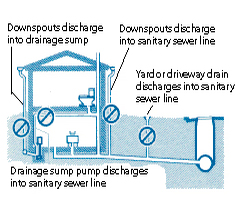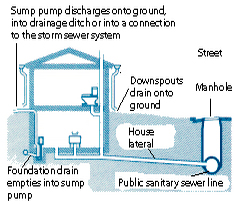
In the ALCOSAN service area, as much as 50-60 percent of inflow and infiltration comes from leaking house laterals and illegally connected roof and foundation drains. Like the more than 4,000 miles of sewer collection system piping through our communities, house laterals in the 83 ALCOSAN neighborhoods represent about the same distance.
Because improper connections represent such a large part of the sewage overflow problem, many communities with sanitary sewer systems have been required to test home connections. Common examples of improper connections include downspouts,groundwater sump pumps, foundation drains and driveway drains. These connections allow stormwater to enter the sanitary sewer line and contribute to the sewage overflows that occur when the system is overloaded.
 Improper Connection
Improper Connection
 Proper Connection
Proper Connection
The most common method for testing home connections is called a dye test. A brightly colored fluorescent dye is inserted into a downspout, sump pump or drain. The dye is flushed through with clear water and if the dye is seen flowing through the sanitary sewer line, the connection is deemed improper and must be corrected. Many communities are actively testing all of the homes in their geographic boundaries, while other municipalities have created an ordinance that dye testing must be completed at the time of a real estate sale.